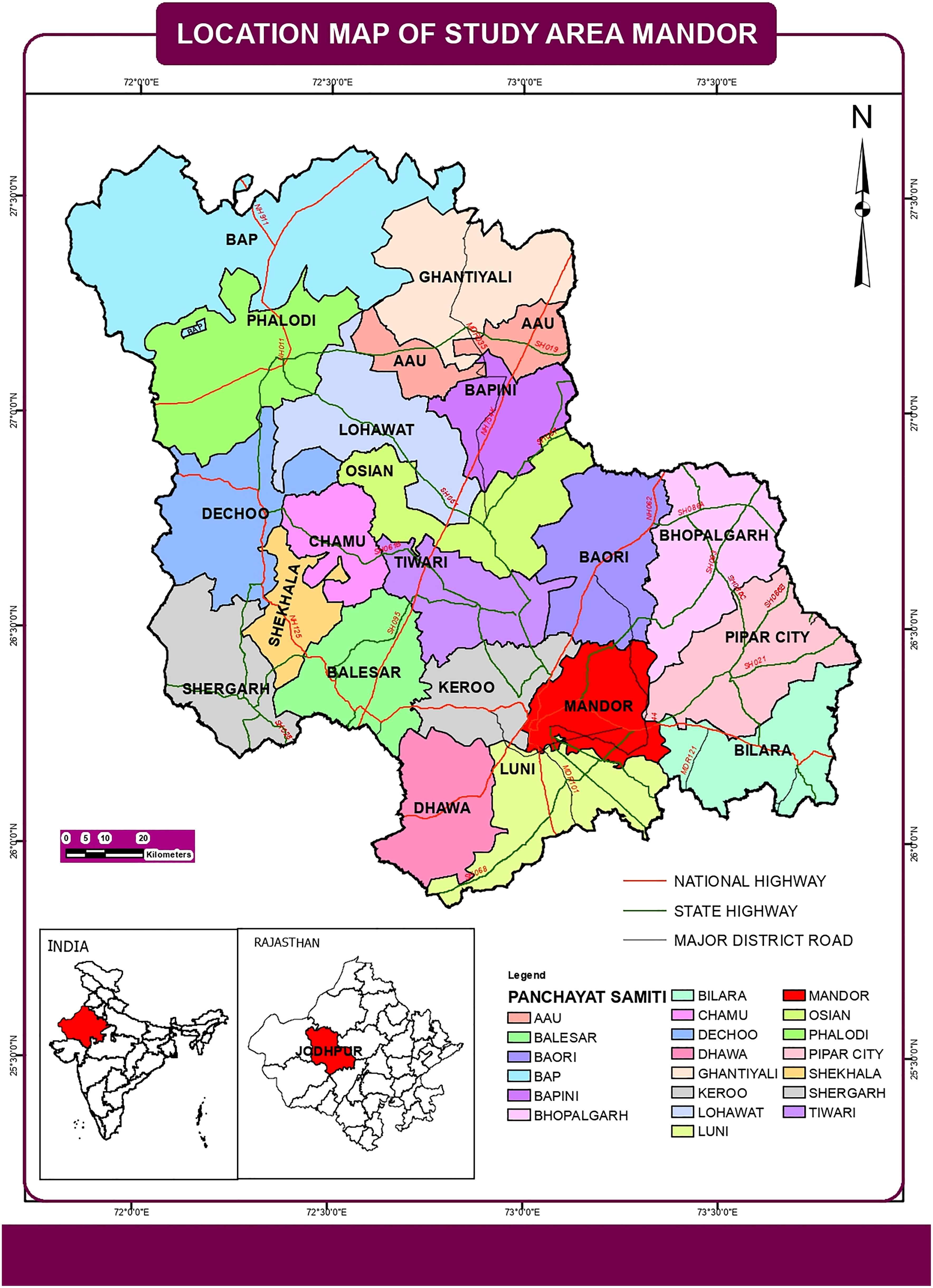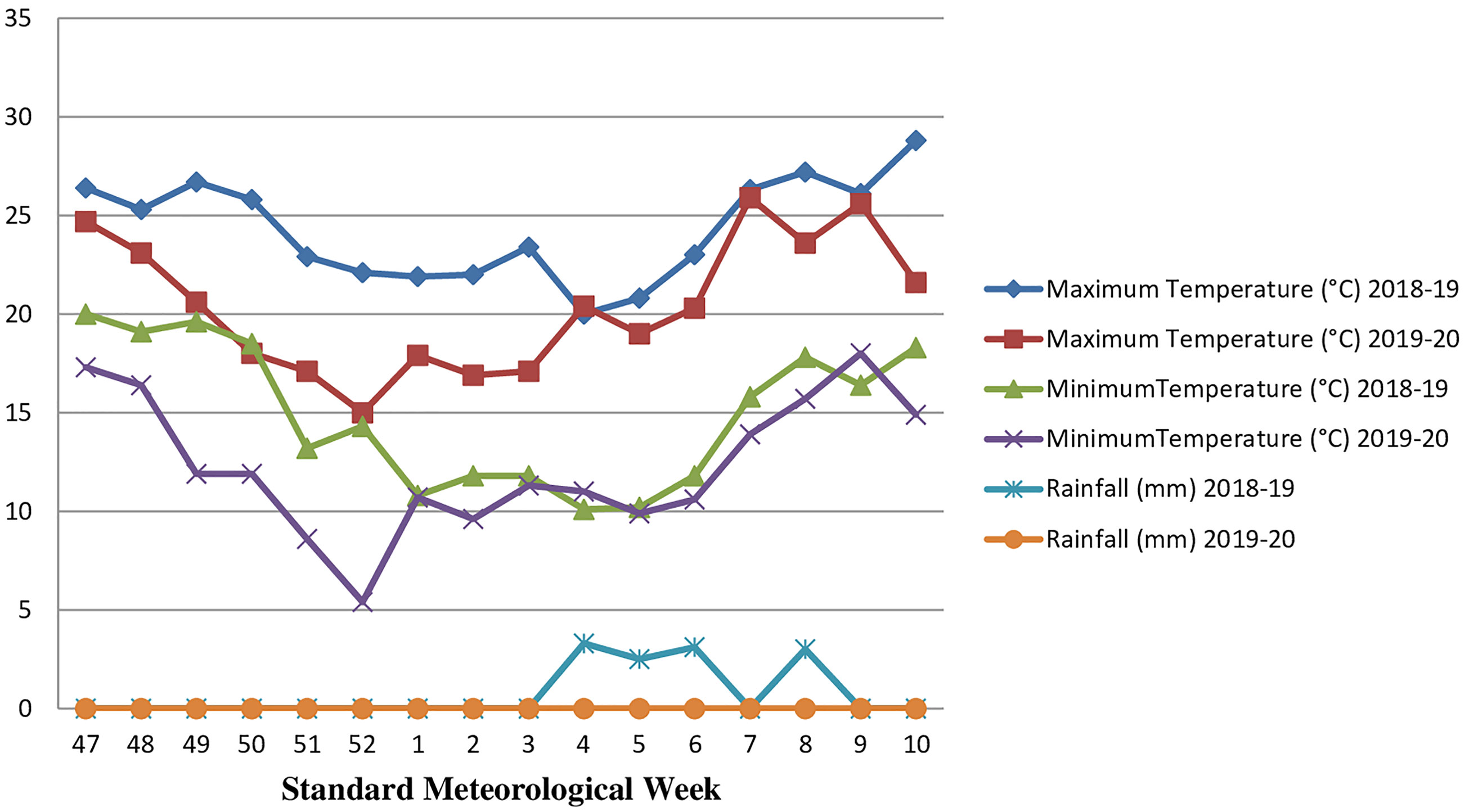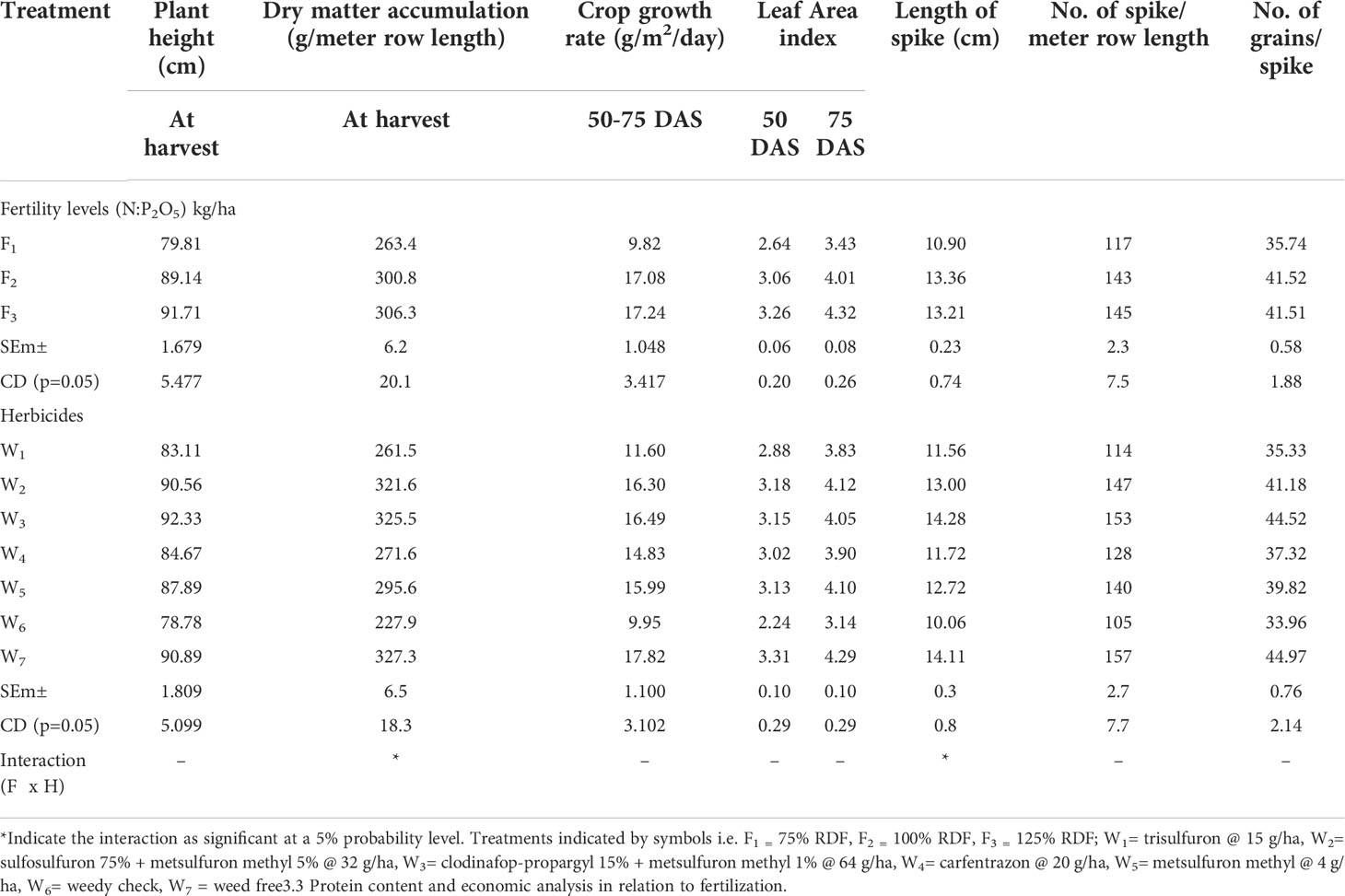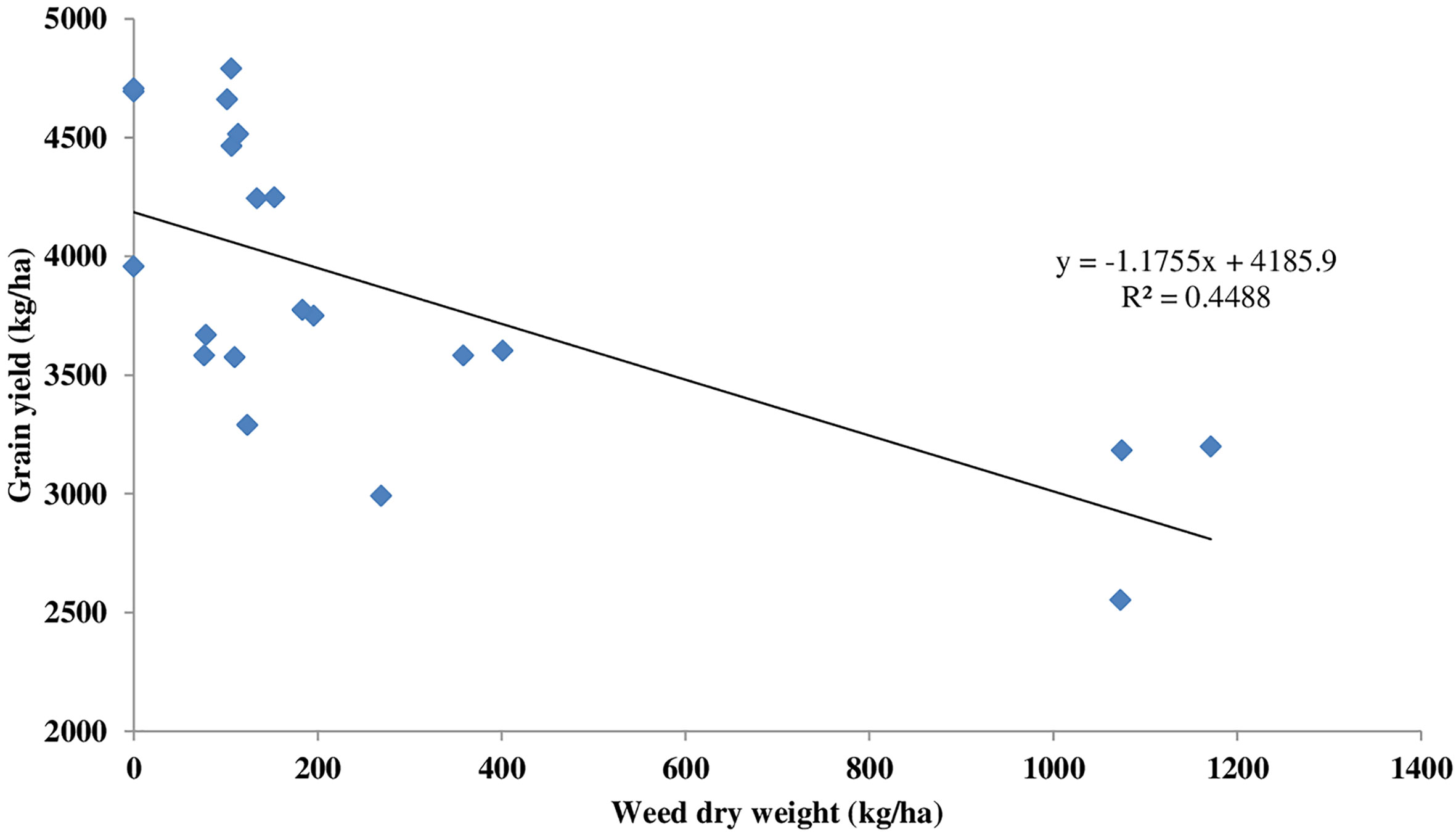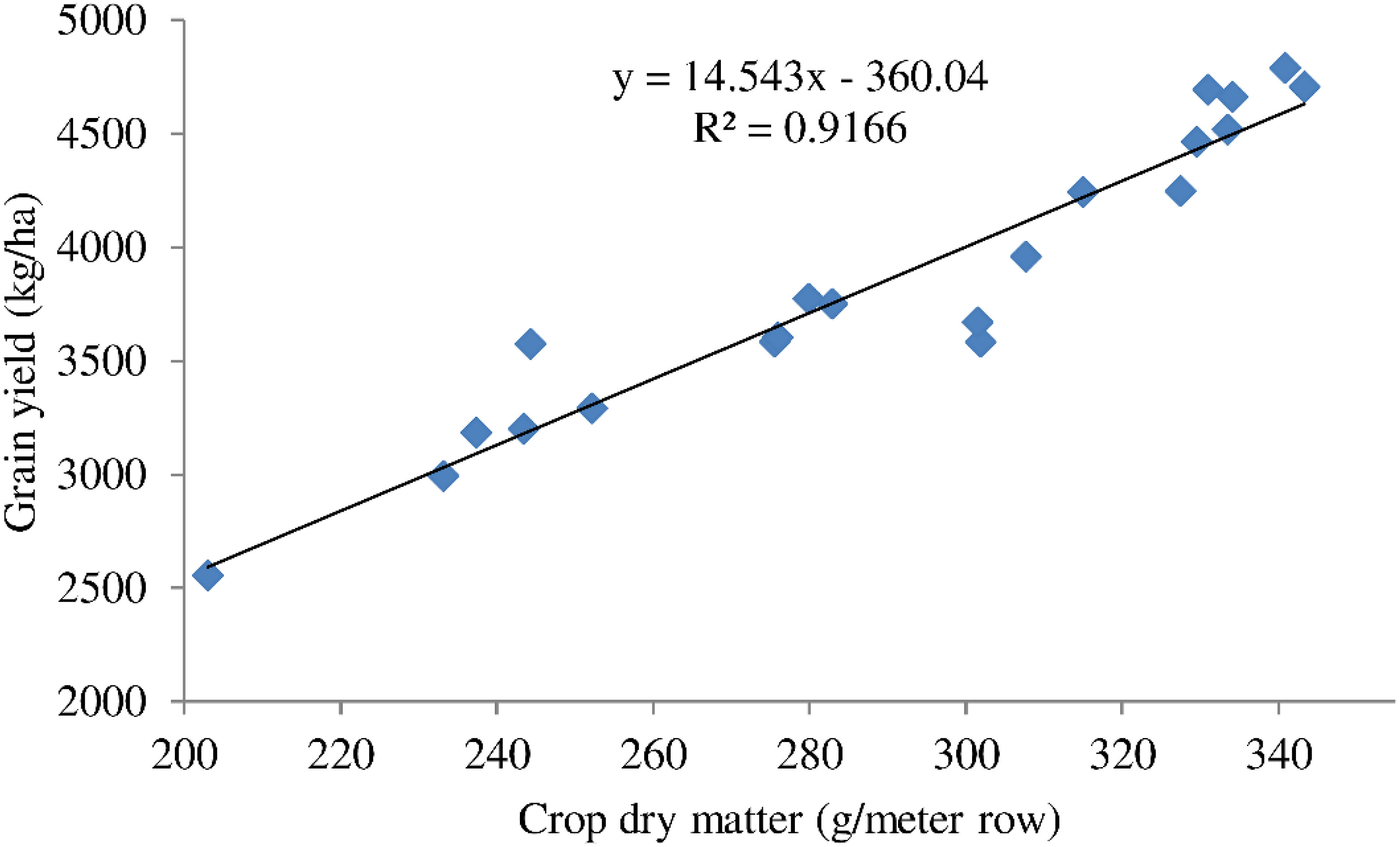- 1College of Agriculture, Agriculture University, Jodhpur, India
- 2Directorates of Extension Education, Agriculture University, Jodhpur, India
- 3Agricultural Research Station, Agriculture University, Jodhpur, India
- 4HCP Division, ICAR-Central Institute of Post Harvest Engineering and Technology (ICAR-CIPHET), Abohar, India
A two-year field experiment was conducted in two consecutive rabi seasons under arid climatic conditions to examine the effect of different fertility levels and herbicides on weed dynamics and the performance of wheat (Triticum aestivum L.). Results revealed that a significantly minimum weed dry weight was recorded with 75% RDF (Recommended Dose of Fertilizer) (90-30 kg N-P2O5/ha). Application of 100% RDF (120-40 kg N-P2O5/ha) recorded significantly higher weed dry weight at 35 DAS (Days After Sowing) (16.50 g/m2) and harvest (28.15 g/m2), growth and yield attributes i.e. plant height (89.14 cm), crop dry matter accumulation (300.8 g/meter row length), crop growth rate (17.08 g/m2/day), leaf area index at 50 DAS (3.06, net assimilation rate 50-75 DAS, length of the spike (13.36 cm), number of grains/spike (41.52), grain yield (4083 kg/ha), straw yield (5019 kg/ha) and biological yield (9103 kg/ha) over 75% RDF. This treatment remains at par with 125% RDF (150-50 kg N-P2O5/ha) except for the leaf area index at 75 DAS. Among the herbicidal treatments, application of the ready-to-use herbicides clodinafop-propargyl 15% + metsulfuron methyl 1% @ 64 g/ha provided a superior value of weed indices i.e. higher weed control efficiency (91.30), crop resistance-index, and herbicide efficiency-index, and lower weed-index (1.91) over other herbicides. This treatment also exhibited significantly higher plant height (92.33 cm), crop dry matter accumulation (325.5g/meter row length), crop growth rate (16.49 g/m2/day), leaf area index (3.15), net assimilation rate, length of the spike (14.28 cm), number of spike/meter row length (153.0), number of grains/spike (44.52), grain yield (4374 kg/ha), straw yield (5381 kg/ha) and biological yield (9755 kg/ha) over weedy check plot, which was followed by sulfosulfuron 75% + metsulfuron methyl 5% @ 32 g/ha, both of which remained statistically at par with each other except for the number of grains/spike. The application of 100% RDF and clodinafop-propargyl 15% + metsulfuron methyl 1% @ 64 g/ha recorded higher net returns and maximum B: C ratio.
Introduction
Cereals are crucial for meeting the global food demand created by growing populations, especially in developing countries where cereals are the primary source of nutrition and calorie intake (Nikos and Jelle, 2012; Shiferaw et al., 2013; Samota et al., 2017; Sasi et al., 2021). It is a significant source of water-soluble protein (Chaquilla-Quilca et al., 2018; Awana et al., 2020), has a good dietary fiber content (Rasane et al., 2013; Ciudad-Mulero et al., 2020), and is loaded with vitamins (mainly vitamin-Bcomplex viz, thiamin, riboflavin, and niacin) and minerals (calcium, iron, magnesium, potassium, zinc, and selenium) (Ciudad-Mulero et al., 2021; Kaur et al., 2022). The soil of India is mostly deficient in Nitrogen, (Mohan et al., 2015), especially, the loamy sand soils of semi-arid areas in Rajasthan. The low productivity of wheat in these areas is due to the lack of availability of phosphorus due to high fixation and nitrogen in the soil. High wheat productivity can be achieved with the balanced and judicious use of chemical fertilizers.
Production of the wheat crop is directly impacted by several biotic and abiotic factors. Among these, the most limiting biological constraint is the infestation of weeds. The yield losses of wheat vary between 17-30% annually (Zand et al., 2007; Rao and Chauhan, 2015), depending on the density and flora of the weed (Jat et al., 2003). Therefore, the management of weeds is a basic requisite for better wheat productivity (Nazari et al., 2013). A combination of cultural and herbicidal applications is used to manage weeds in wheat crops (Chachar et al., 2009; Knezevic et al., 2012). Chemical control is majorly used as it is a quick, more effective, time and labor-saving method for controlling weeds in wheat (Mehmeti et al., 2018). The constant use of herbicides acting on the same site led to multiple herbicide resistance (Singh et al., 2009). A mixture of more than one herbicide is essential for the effective management of multiple weed flora. Herbicide combinations improve weed control efficacy against weed flora (Singh et al., 2011), and also delay resistance against herbicides (Wrubel and Gressel, 1994). Acetolactate synthase (ALS)-inhibiting herbicides are employed in winter wheat to control broadleaf and annual grass weeds. They are used extensively due to their low adverse effect on the environment, low mammalian toxicity, and high efficacy rate (Khaliq et al., 2011; Reddy et al., 2013). This study aimed to investigate the effect of adequate fertilization along with herbicidal weed management for the stable production of wheat.
Materials and methods
Experimental site
Field experiments were performed during two consecutive Rabi seasons in 2018-19 and 2019-20 at the Institutional Farm, College of Agriculture- Mandor, Jodhpur, Rajasthan, India to study the effect of fertility levels and different herbicides on the productivity of wheat. Geographically, it is located between 26° 15’ N to 26° 45’ N and 73° 00’ E to 73° 29’ E at an altitude of 231 meters (Figure 1). This area comes under the agro-climatic zone Ia (Arid Western Plains Zone) of Rajasthan. The average annual rainfall is about 367 mm and the bulk of it is received from June to September (Kharif season i.e., 85 to 90%).
Observation of meteorological parameters
The periodical means for weekly weather parameters were recorded from the meteorological observatory of the Agricultural Research Station, Mandor (Jodhpur). The mean daily maximum and minimum temperatures varied between 20 to 28.8°C and 10.1 to 20.0°C, respectively in 2018-19, and the corresponding values in the year 2019-20 were 15 to 25.9°C and 5.4 to 18.0°C during the crop growing seasons (Figure 2).
The maximum temperatures during the crop-growing period i.e., 2018-19 and 2019-20, were 28.8 and 25.9°C; however, the corresponding values for minimum temperatures were 10.1 and 5.4°C. The annual rainfall was 11.9 mm during the first year of the crop-growing period, but no rainfall occurred the next year. The maximum and minimum relative humidity during the crop-growing period were 68.20% and 20.10% in 2018-19 and 76.90 and 15.9% in 2019-20 (Figure 2).
Physico-chemical properties of soil and nitrogen, phosphorus, and potassium analysis in soil
The soil samples from 0-30 cm depth were drawn randomly from different spots of the experimental field with the help of a screw auger to find out the physico-chemical properties and fertility status of the soil. The results revealed that the soil was loamy sand in texture, bulk density (1.72-1.77 Mg/m3), particle density (3.18-3.20 Mg/m3) moderately alkaline (pH = 8.0), and low in organic carbon content (0.12-0.15%). The available nutrients initially present in soils were evaluated using protocols of Subbiah and Asija (1956); the Olsen et al. (1954) for phosphorus and the flame photometer method of Standfold and English (1949) for Potassium. The pH and organic carbon content of soil were also estimated prior to sowing the crop using Singh et al., 2011 and Walkley and Black, 1964 protocols respectively. The results revealed a low level of nitrogen (174.2-175.1 kg/ha), a medium level of phosphorus (20.3-21.0 kg/ha), and a high level of potassium (324.4-325.2 kg/ha) in the soil.
Treatments followed during field experiments
Wheat variety ‘GW 11’ was shown at a row-to-row spacing of 22.5 cm using 100 kg seeds/ha. The treatments comprising of three fertility levels [75% RDF (90-30 kg N-P2O5/ha), 100% RDF (120-40 kg N-P2O5/ha) and 125% RDF (150-50 kg N-P2O5/ha)] in main plots and seven different herbicidal treatments (trisulfuron @ 15 g/ha, sulfosulfuron 75% + metsulfuron methyl 5% @ 32 g/ha, clodinafop-propargyl 15% + metsulfuron methyl 1% @ 64 g/ha, carfentrazon @ 20 g/ha, metsulfuron methyl @ 4 g/ha, weedy check and weed-free) in subplots were laid out in Split Plot Design and replicated thrice. Fertility levels were applied through DAP and urea. At the time of sowing, half of N and a full dose of P were applied as basal doses. At the time of the first and second irrigation, the remaining quantity of N was applied as a top dressing in a standing crop through urea in two equal split doses. The post-emergence application of herbicides was done at 35 DAS as per treatment using a flat fan nozzle and foot sprayer with a spray volume of 600 liters of water per hectare. Weed-free plots were weeded regularly to keep them weed-free throughout the crop pendency.
Weed dynamics study
The total weed density (number/m2) and weed dry weight (g/m2) were recorded for every treatment with the help of a 0.25m2 quadrate and then converted into m2. Data of these parameters were transformed using ( to compare the treatments. Weed control efficiency was determined using the standard procedure suggested by Umrani and Boi (1982).
Where,
X = Weed dry matter in weedy check plot
Y = Weed dry matter in the treated plot
The weed index is a derived parameter from the crop yields obtained across the treatments of weed control research (Yadav and Mishra, 1982). The following formula was used in calculating the weed index:
Where,
X = Crop yield in weed-free plots (kg/ha)
Y = Crop yield in the treated plot (kg/ha)
The herbicide efficiency index was calculated by employing the given formula as suggested by Krishnamurthy et al. (1975):
Where,
Yt- crop yield from the treated plot
Yc- crop yield from weedy check plot
WDMt- weed dry matter in the treated plot
WDMc- weed dry matter in weedy check plot
The crop resistance index was computed using the formula given by Misra and Misra (1997):
Growth indices, growth, and yield parameters
Growth indices i.e. leaf area index (LAI), crop growth rate (CGR), and net assimilation ratio (NAR) were estimated by employing the standard formula. The observation of plant height, spike length, and the number of grains per spike were written down manually for five randomly picked adumbrative plants from each plot of respective replication separately, and the yield-attributing character and yield were also reported. The grain and straw yield was estimated from the net plot area of the respective treatment.
Protein content analysis
The crude protein content in grain samples was determined by multiplying respective grain nitrogen concentration (%) by the factor of 6.25 (Simson et al., 1965).
Economic analysis
To compare the returns of several fertility levels and herbicides, an economic analysis was performed. Net return was evaluated by subtracting the total cost of production from the gross income examined from wheat grain and straw yield. The cost of urea, DAP, and all herbicides was calculated. The various production costs including labor (land preparation, seeds, sowing, weeding, fertilizer application, spraying, and harvesting) and chemicals (insecticides and pesticides) were computed.
Statistical analysis
The experimental data were recorded from the random distribution of treatments in three replications and subjected to statistical analysis. The experimental data were statistically analyzed using the Analysis of Variance (ANOVA) test (Panse and Sukhatme, 1985). The least significant difference (LSD) was calculated for the comparison among treatments, where the variance ratio (F test) was found to be significant at a 5% level of probability. To create a simple linear regression model for an explanation using XLSTAT software.
Results
Weed response to nitrogen and phosphorus fertilizer
Weeds, namely, Chenopodium murale L., Chenopodium album L., Rumex dentatus L., Asphodelus tenuifolius L., Melilotus alba, Melilotus indica, Fumaria parviflora, Cynodon dactylon L., Launaea asplenifolia and Cyperus rotundus L were present in the field. We observed that the broad-leaved weeds were dominated by grassy and sedge weeds.
The study revealed that different levels of nitrogen and phosphorus fertilization significantly influenced weed dry weight in the wheat crop field. The maximum number of total weeds (35 and 50 DAS) was recorded with a fertility level of 125% RDF, with no significant difference in fertility levels. The notable lowest weed dry weight at all respective stages was recorded with the application of 75% RDF over 100 and 125% RDF. 125% RDF results in maximum weed dry weight at 50 DAS of 17.87 g/m2 and it was significantly higher over 100 and 75% RDF by 15.6 and 26.1%, respectively. The corresponding increase in weed dry weight at 75 DAS was 19.12 and 29.55% (Table 1). ANOVA results for weed parameters in wheat crops showed that interaction (F x H) was significant (5% probability) for weed density and weed dry weight at all observed stages. Fertility levels (N: P2O5) had a significant positive relationship with weed dry weight with a regression coefficient of 0.113 (Figure 3).
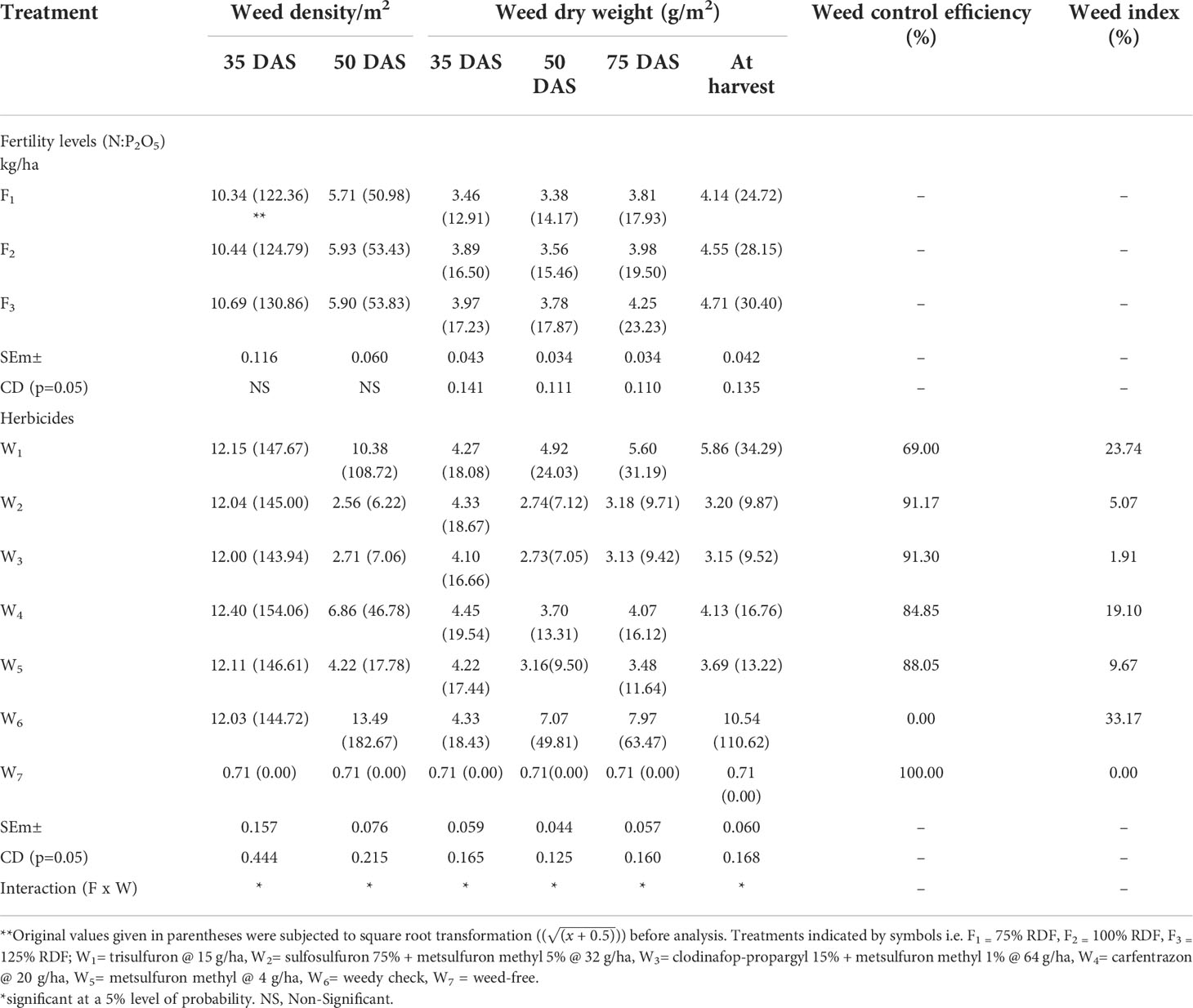
Table 1 Effect of fertility levels and herbicides on total weed density, total weed dry weight, weed control efficiency, and weed index on a pooled basis.
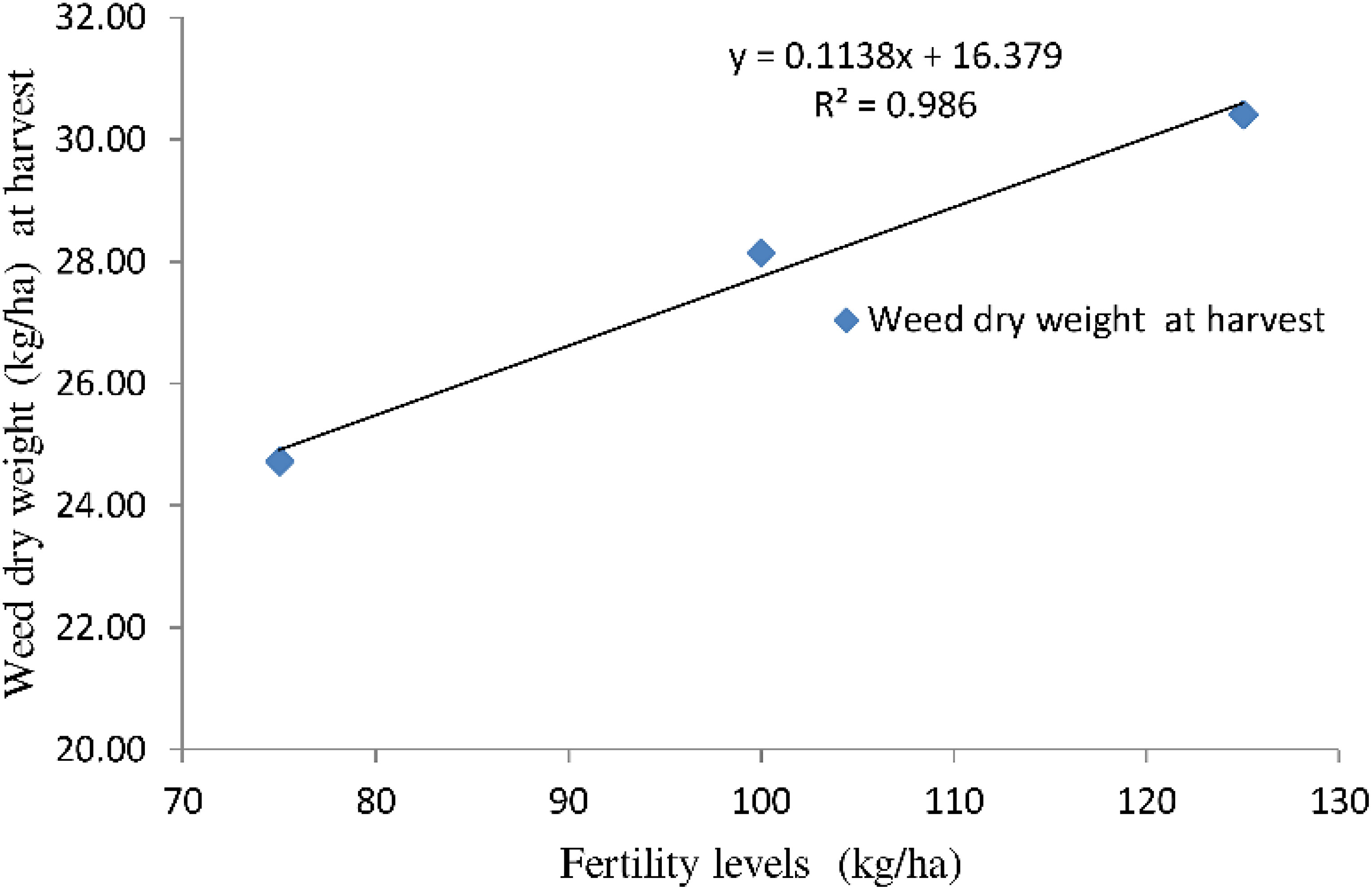
Figure 3 Linear regression analysis between fertility levels and weed dry weight at harvest. These three points denote 75, 100, and 125% RDF levels.
Wheat response to nitrogen and phosphorus fertilizer
A considerable effect of different fertility levels on wheat growth and yield parameters was observed viz. plant height (cm), dry matter accumulation (g/meter row length), CGR, LAI, NAR, length of the spike (cm), number of spikes/meter row length, number of grains/spike, grain yield (kg/ha), straw yield (kg/ha) except for the harvest index during the mean of experimental years (Table 2; Figure 4). The maximum plant height (91.71 cm) was recorded with the application of a 125% recommended dose of fertilizer over 75% RDF but, remain at par with 100% RDF over the years of study. Application of 100 and 125% RDF enhanced the crop dry matter significantly by 14.2 and 16.3% over 75% RDF on a pooled basis, respectively. Enhancing fertility levels from 75 to 100% RDF was associated with a significant acceleration in crop growth rate over the seasons of study. The maximum leaf area index (3.26 at 50 DAS and 4.32 at 75 DAS) was recorded under fertilization with 125% RDF. The highest net assimilation rate (5.57 g/m2 leaf area/day) was recorded with 100% RDF (Figure 4). The fertility levels had a significant positive correlation with crop dry matter based on regression analysis (Figure 5).
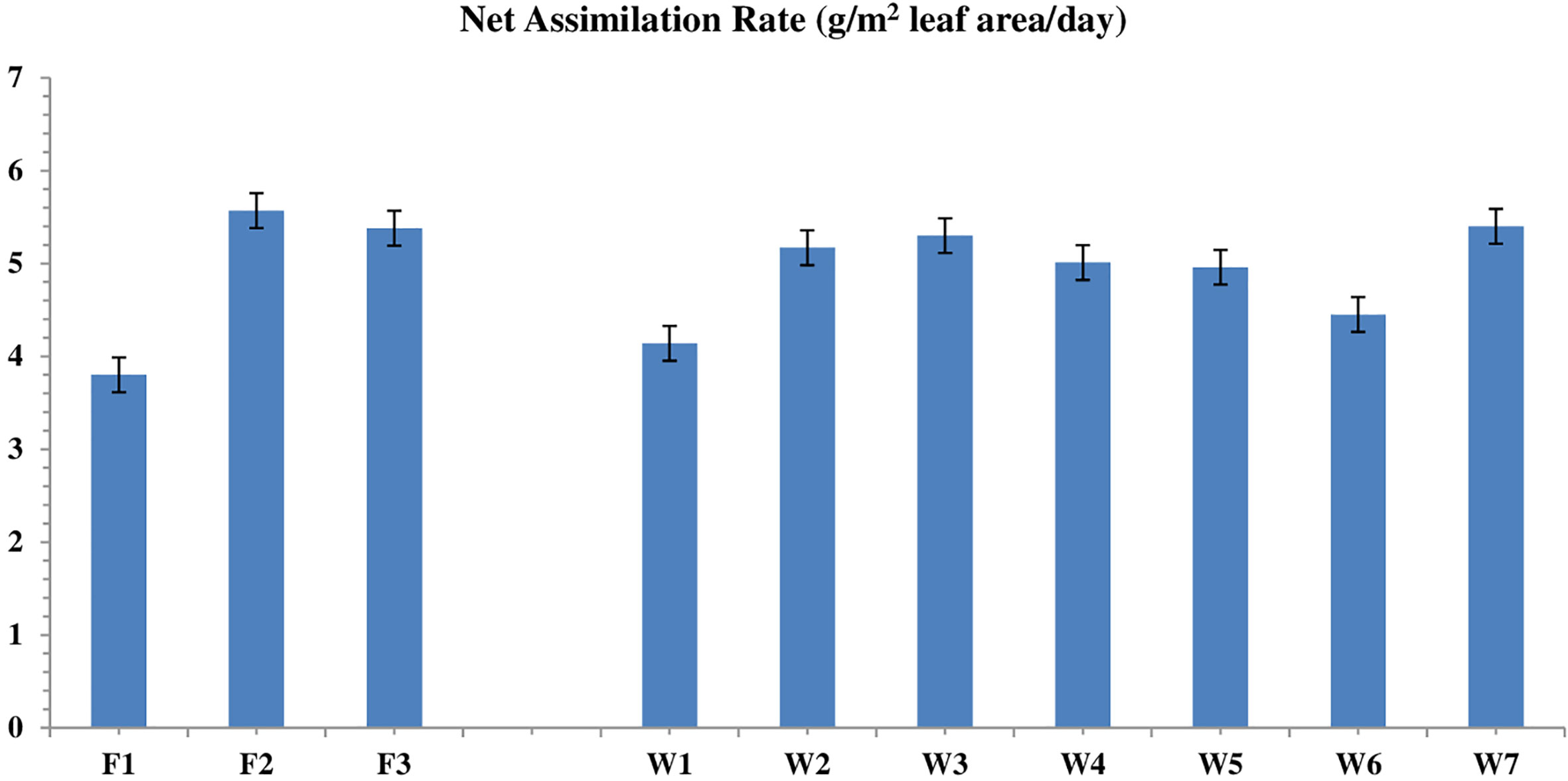
Figure 4 Effect of fertility levels and herbicides on net assimilation ratio (pooled basis). Treatment symbols indicated by F1 = 75% RDF, F2 = 100% RDF, F3 = 125% RDF; W1= trisulfuron @ 15 g/ha, W2= sulfosulfuron 75% + metsulfuron methyl 5% @ 32 g/ha, W3= clodinafop-propargyl 15% + metsulfuron methyl 1% @ 64 g/ha, W4 = carfentrazon @ 20 g/ha, W5= metsulfuron methyl @ 4 g/ha, W6= weedy check, W7 = weed free. The critical difference (p= 0.05) and standard error of mean between treatments were 1.142 and 0.408, respectively.
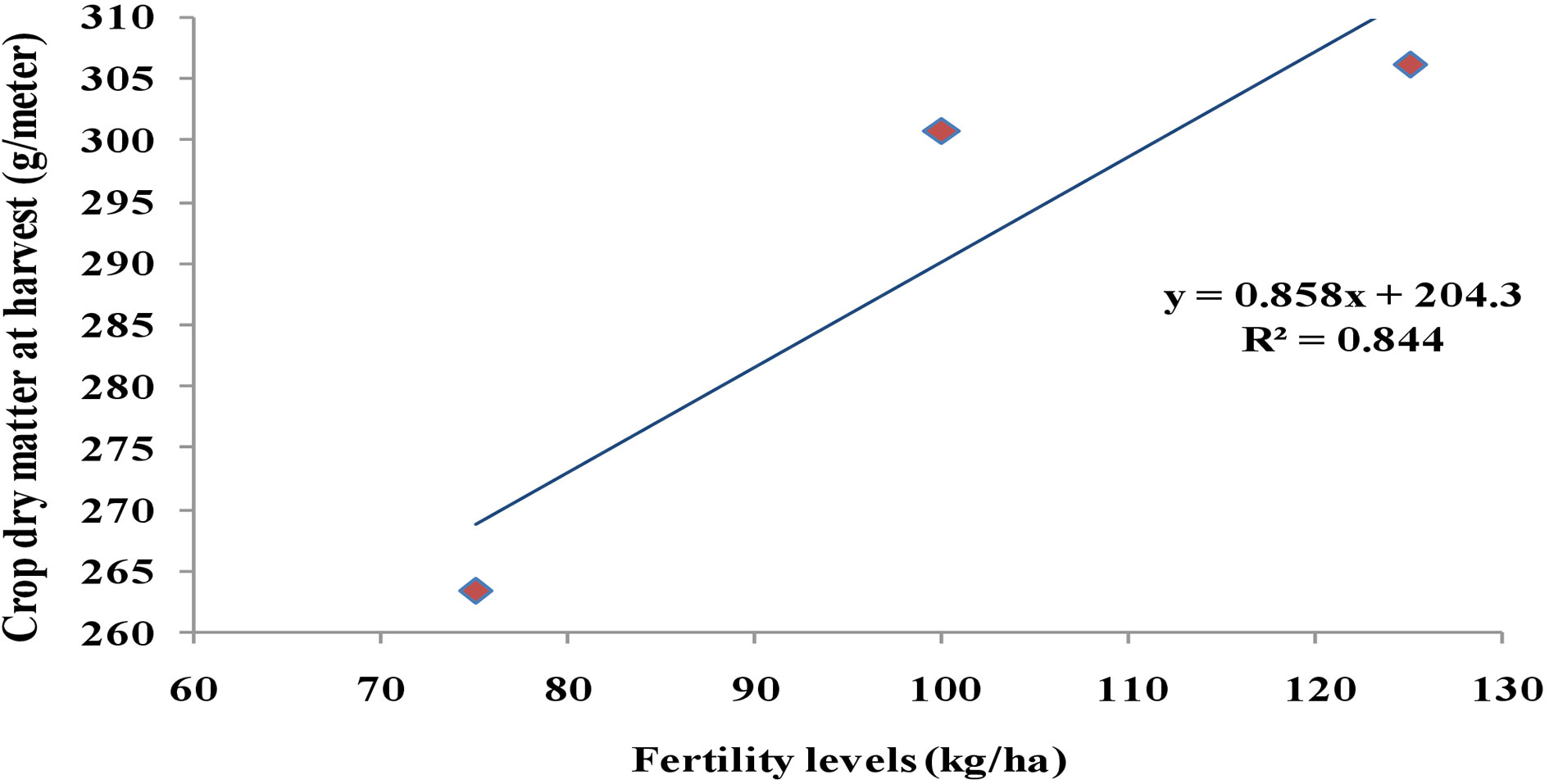
Figure 5 Linear regression analysis between fertility levels and crop dry matter at harvest. These three points denote 75, 100, and 125% RDF levels.
The number of spikes was significantly influenced by 100 and 125% RDF by 24.00 and 22.22% compared to 75% RDF. An application of 100% RDF significantly increased the spike length by 22.6% over 75% RDF. On a pooled basis, an increase in RDF from 75-100% results in a significant increase in the number of grains/spike by 16.2% (Table 3). The correlation analysis revealed a negative correlation between weed dry weight and grain yield at 5%, with a regression coefficient value of -1.175 (Figure 6). The application of 100% and 125% DF significantly improved the grain yield by 21.0% and 22.1% respectively, compared to 75% RDF. Corresponding increased due to application of 125% RDF was 22.1%. Here 22.1% increase in grain yield due to 125% RDF. On the pooled basis, 100 and 125% RDF application significantly influenced straw yield by 752 and 841 kg/ha over 75% RDF, respectively. Raising the fertility level from 75-100% RDF was associated with a significant enhancement in total biomass (grain and straw yield) by 1461 kg/ha, however, a further increase in RDF application from 100-125% did not significantly influence total biomass production. Regression analysis showed a significant positive effect of crop dry matter on the grain yield of wheat with a regression coefficient value of 14.54 (Figure 7). ANOVA for wheat plant growth and yield revealed that interaction between fertility levels (F) and herbicides (H) was highly significant (at 5% probability). There was also a significance (5% probability) between dry matter and the length of the spike (Table 1).
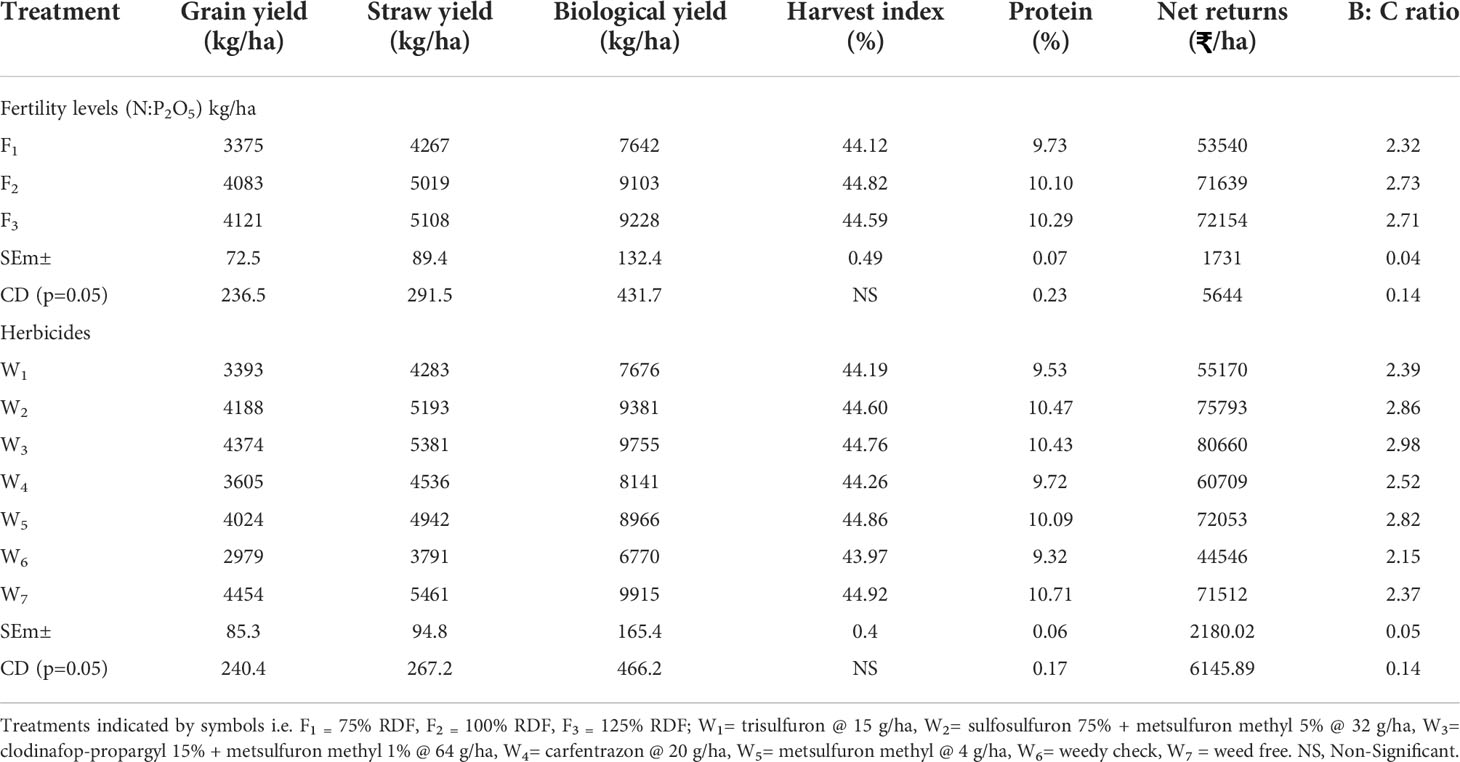
Table 3 Effect of fertility levels and herbicides on yield, harvest index, the protein content of wheat, and economic analysis.
The fertility levels significantly influence the protein content, and gross and net returns of wheat over 75% RDF. The average of the year’s experiments revealed that 100 and 125% RDF application significantly improved the protein content by 3.8% and 5.7% over 75% RDF, respectively. ANOVA results showed that the interaction (F x H) between fertility levels (F) and herbicides (H) was not significant (5% probability) for protein content in wheat grain (Table 3).
The highest net return was observed in the application of 125% RDF (72,154 ₹/ha), while the maximum B:C ratio was recorded with 100% RDF. ANOVA results showed that the interaction between interaction between fertility levels (F) and herbicides (H) was significant (5% probability) for net returns and the B:C ratio (Table 3).
Weed response to herbicides
The study revealed that weed density (50 DAS) and the dry weight of weeds at all observed growth stages were drastically decreased in all the herbicidal treatments in comparison to the weedy check plot on the pooled basis (Table 1). Among herbicides, application of clodinafop-propargyl 15% + metsulfuron methyl 1% @ 64 g/ha gave minimum weed density and weed dry weight after spray and it was on par with sulfosulfuron 75% + metsulfuron methyl 5% @ 32 g/ha.
In the present investigation, the post-emergence application of herbicides exhibited maximum efficiency of weed control, herbicide efficiency index, crop resistance index, and lower weed index after a weed-free check over an unweeded plot (Table 1; Figures 8, 9). The highest weed control efficiency was achieved by clodinafop-propargyl 15% + metsulfuron methyl 1% @ 64 g/ha(91.30%) followed by application of sulfosulfuron 75% + metsulfuron methyl 5% @ 32 g/ha(91.17%), metsulfuron methyl @ 4 g/ha (88.05%). Among the herbicides, the lowest weed index (WI) of 1.91 was recorded by application of clodinafop-propargyl 15% + metsulfuron methyl 1% @ 64 g/ha whereas the second lowest WI (5.07) was observed with application of sulfosulfuron 75% + metsulfuron methyl 5% @ 32 g/ha. Similarly, the maximum herbicide efficiency index and crop resistance index were also recorded with the application of clodinafop-propargyl 15% + metsulfuron methyl 1% @ 64 g/ha.
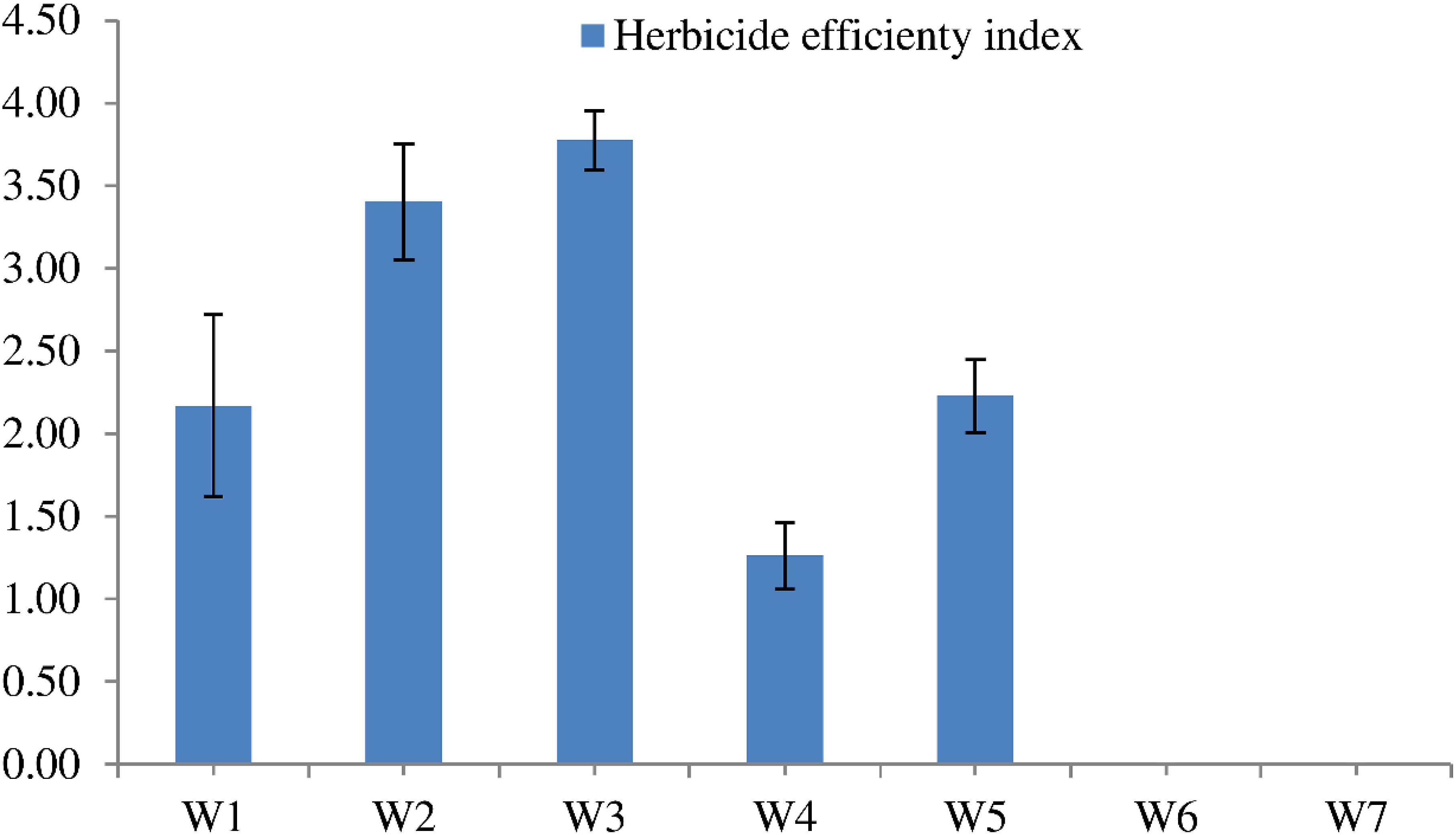
Figure 8 Influence of herbicides on herbicide efficiency index (pooled basis). The vertical bar indicates standard errors. Treatment symbols indicated by W1= trisulfuron @ 15 g/ha, W2= sulfosulfuron 75% + metsulfuron methyl 5% @ 32 g/ha, W3= clodinafop-propargyl 15% + metsulfuron methyl 1% @ 64 g/ha, W4 = carfentrazon @ 20 g/ha, W5= metsulfuron methyl @ 4 g/ha, W6= weedy check, W7 = weed free. The critical difference (p= 0.05) and standard error of mean between treatments were 0.42 and 0.15, respectively.
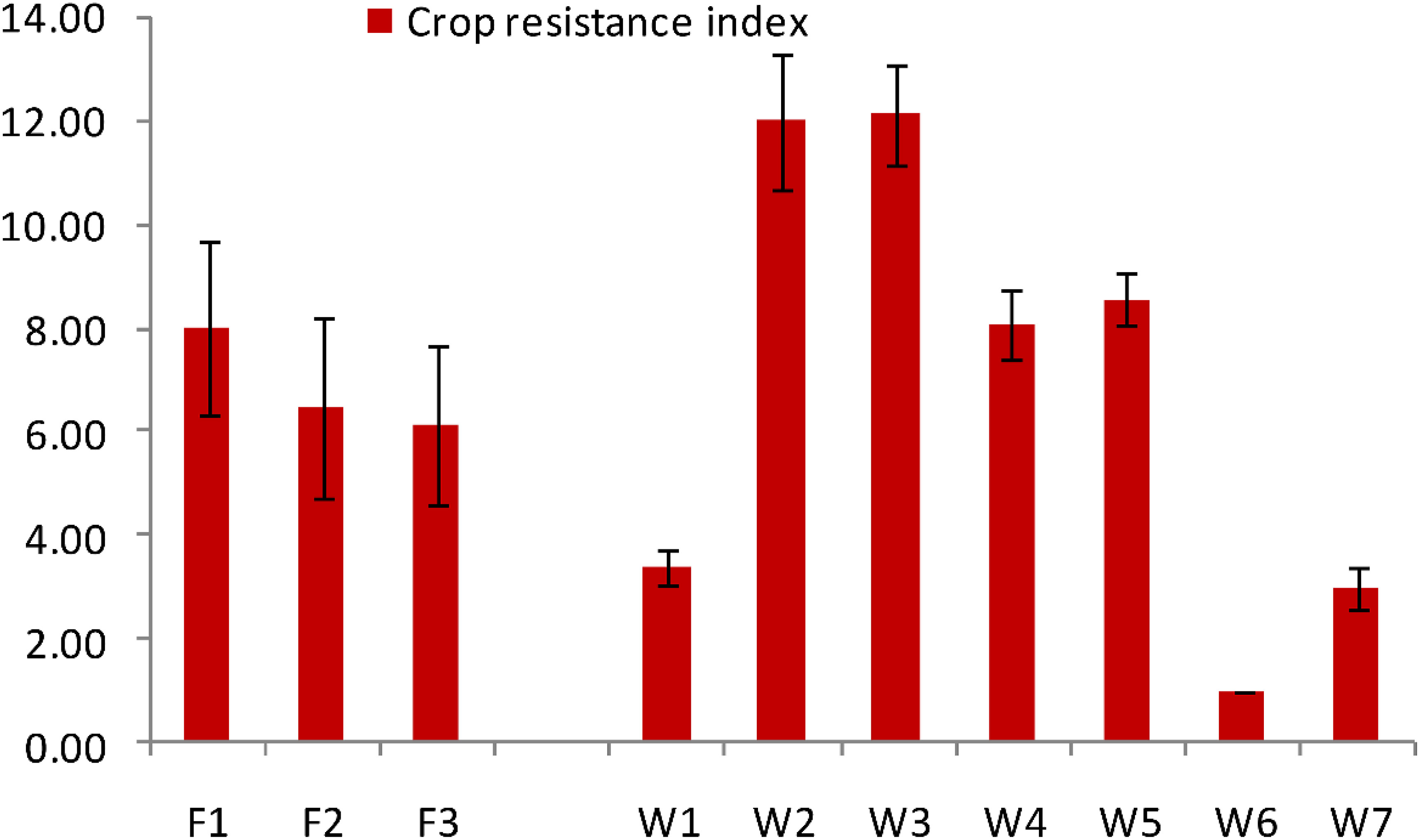
Figure 9 Effect of herbicides on crop resistance index (pooled basis). The vertical bar indicates standard errors. Treatment symbols indicated by W1= trisulfuron @ 15 g/ha, W2= sulfosulfuron 75% + metsulfuron methyl 5% @ 32 g/ha, W3= clodinafop-propargyl 15% + metsulfuron methyl 1% @ 64 g/ha, W4 = carfentrazon @ 20 g/ha, W5= metsulfuron methyl @ 4 g/ha, W6= weedy check, W7 = weed free. The critical difference (p= 0.05) and standard error of mean between treatments were 0.27 and 0.76, respectively.
Wheat response to post-emergence herbicides
The result revealed that the application of herbicidal management practices significantly improved different growth attributes i.e. plant height and dry matter accumulation recorded at the harvest stage, LAI at 50 and 75 DAS, net assimilation ratio, and crop growth rate between 50-75 DAS, length of the spike (cm), number of spikes/meter row length, number of grains/spike grain, straw and biological yield except for harvest index during pooled basis (Tables 2, 3; Figure 4). An application of clodinafop-propargyl 15% + metsulfuron methyl 1% @ 64 g/ha and sulfosulfuron 75% + metsulfuron methyl 5% @ 32 g/ha considerably enhanced the plant height by 17.2 and 15.0% over season-long weedy plot, respectively. Clodinafop-propargyl 15% + metsulfuron methyl 1% @ 64 g/ha application as post-emergence recorded significantly higher crop dry matter production over trisulfuron @ 15 g/ha, metsulfuron methyl at 4 g/ha and weedy check to the magnitude of 24.5, 10.1 and 42.9%, respectively. On the pooled basis, crop growth rate (CGR) recorded between 50-75 DAS was highest under weed free treatment (7.87 g/m2/day) and it was at par with all other herbicidal treatments except trisulfuron @ 15 g/ha and carfentrazone @ 20 g/ha. The highest leaf area index (3.18 at 50 DAS and 4.12 at 75 DAS) was obtained under the application of sulfosulfuron 75% + metsulfuron methyl 5% @ 32 g/ha while it was at par with all treatments except triasulfuron 15 g/ha at 50 DAS and weedy check at 75 DAS. The maximum net assimilation rate (NAR) was recorded with clodinafop-propargyl 15% + metsulfuron methyl 1% @ 64 g/ha however, it was at par with all other treatments except triasulfuron 15 g/ha.
Compared to weedy check plots, all the herbicidal treatments had a positive effect on the number of spikes/meter row length. Clodinafop-propargyl 15% + metsulfuron methyl 1% @ 64 g/ha, sulfosulfuron 75% + metsulfuron methyl 5% @ 32 g/ha and metsulfuron methyl @ 4 g/ha were at par with each other over the study of experiment. These three treatments explicated 45.7, 40.0, and 33.33% increase in the number of spikes/meter row length, respectively over weedy check. An application of clodinafop-propargyl 15% + metsulfuron methyl 1% @ 64 g/ha significantly increased length of spike and number of grains/spike by 42.0 and 31.09%, over weedy check respectively,. Application of clodinafop-propargyl 15% + metsulfuron methyl 1% @ 64 g/ha produced maximum grain yield of 4374 kg/ha which was at par with weed free (4454 kg/ha) check and sulfosulfuron 75% + metsulfuron methyl 5% @ 32 g/ha (4188 kg/ha). Similar results were recorded with straw and biological yield.
Protein content of wheat grain and economic analysis in relation to herbicides
The herbicidal weed management treatments significantly influence the protein content, and gross and net returns of wheat over an un-weeded plot. Weed-free plot showed notably highest protein content (10.71%) in grain over rest of treatments followed by sulfosulfuron 75% + metsulfuron methyl 5% @ 32 g/ha (10.47%) and clodinafop-propargyl 15% + metsulfuron methyl 1% @ 64 g/ha (10.43%).
The herbicidal treatment enhanced the net return and B: C ratio as compared to the weedy check plot (Table 3). The highest net return and B: C ratio were recorded (₹/ha 80,660 and 2.98) after application of clodinafop-propargyl 15% + metsulfuron methyl 1% @ 64 g/ha. This treatment was at par with application of sulfosulfuron 75% WG @ 25 g a.i./ha + metsulfuron 5% WG @ 2 g a.i./ha (₹/ha 75,793 and 2.86).
Discussion
Weeds’ response to nitrogen and phosphorus fertilizer
Our result showed that the maximum weed dry weight was recorded under higher fertility levels over lower levels based on year averages. Similar results were observed by Babar et al. (2019). It might be attributed to the ample availability of nutrients for weeds under the influence of higher levels of nitrogen and phosphorus fertilization resulting in better vegetative growth, expansion of leaf area of weed plants, accelerated photosynthetic rate, and better inception of solar radiation which ultimately increase the dry weight of weeds. Chauhan et al., (2017), and Ashrafi et al. (2010) also reported similar results and revealed a notable increase in weed dry matter with a successive increase in nitrogen levels up to 120 kg/ha. Many researchers reported that applied fertilizer gave more benefits to weeds compared to wheat crops as weeds were more competitive than crops for nutrients (Carlson and Hill, 1986; Blackshaw et al., 2003). Blackshaw (2005) observed a lower dry weight of weed recorded from the control plot where no fertilizer was applied and vice-versa.
Wheat response to nitrogen and phosphorus fertilizer
Our results showed that the maximum wheat plant growth and yield attributing characteristics were recorded with the application of fertility levels with 100 and 125% RDF during both years of the experiment. Tomar et al. (2017) and Singh et al. (2018) also observed that the use of a higher dose of NPK/ha considerably enhanced the plant height, the number of spikes, dry matter accumulation, and leaf area index over a lower dose of nitrogen and phosphorus. The reason behind the higher growth and yield is nitrogen and phosphorus nutrition at optimum and higher RDF levels, which might have increased root length and root area (Popovic, 2015; Leghari et al., 2016; (Chopra et al., 2017), resulting in the better uptake of other nutrients (Bloom, 2015; Hemerly, 2016). This efficient absorption and utilization of other minerals might have favored the vigorous growth of crop plants (Ahmad et al., 2009; Rafiq et al., 2010) under a high fertility level followed by the optimum level of fertility. If nitrogen is applied in too little an amount, then it directly minimizes the crop yield while an excess amount of nitrogen also negatively affects the plant and this concern gets well defined in crop production (Magistad et al., 1945). Since phosphorus is a component of nucleic acid, phytin, and phospholipids, its higher uptake led to better growth of the plant, eventually leading to yield improvement (White and Veneklaas, 2012). Similar results were observed in different studies (Samimi and Thomas, 2016; Singh et al., 2018; Babar et al., 2019; Gupta et al., 2019).
Protein content and economic analysis in relation to fertilization
Nitrogen supply enhanced the accumulation of nitrogen in wheat grains, which increased protein content (Rodriguez-Felix et al., 2014; Mariem et al., 2020), but an over-dose application of nitrogen decreased protein content. Makowska et al. (2008) found a positive correlation between nitrogen dose and protein content in durum wheat grains. The reduction in protein content was thought to be the result of the lesser availability of nutrients. The nutritional quality of the wheat seeds is dependent on the growing conditions, soil fertility, fertilizer practice, water availability, genotype, grain handling, and storage conditions (Jayas et al., 2008; Carson & Edwards, 2009; Popovic, 2015). Rahim et al. (2010) and Shahbazi and Nematollahi, (2022) found that with an increase in phosphorus fertilizer, there was an increment in the protein content of wheat grains.
The economic results obtained in the present study were found to be similar to the study by Sharma et al. (2018) and Tiwari et al. (2017). The cost of this treatment was comparatively less than its additional income, which directs more returns to this treatment. Our results were also comparable with the results of Gupta et al. (2007) and Niamatullah et al. (2011) on the wheat crop.
Weed response to herbicides
In the present investigation, the post-emergence application of herbicides exhibited maximum weed control efficiency, herbicide efficiency index, crop resistance index, and lower weed index after a weed-free check over an unweeded plot, probably because of the inhibition of acetolactate synthase (ALS) by the application of clodinafop-propargyl + metsulfuron methyl as well as sulfosulfuron + metsulfuron methyl, which performs as a catalyst for the branched-chain amino acidsbiosynthesisi.e. valine, leucine, and isoleucine (Meena et al., 2019), and is thereby responsible for the higher potency of clodinafop-propargyl + metsulfuron methyl and sulfosulfuron + metsulfuron methyl in selectively killing both narrow leaf weeds and broadleaf weeds. In the weedy check plots, the weed dry matter enhanced up to the harvest of the crop, which might be because of the aggressive nature of weeds and better adaptability to environmental conditions. Many studies (Deshmukh et al., 2020; Choudhary et al. (2021); Kien et al., 2016) have reported a similar pattern and showed that clodinafop-propargyl + metsulfuron-methyl was superior in reducing the density of weeds and total dry weight of weeds as compared to weedy check plot. This might be due to the mixed application of herbicides, showing both foliar and soil activities against weeds that interrupt cell division by inhibiting the ALS enzyme and as a result, blocking amino acid biosynthesis; hence, the weed plants undergo selectively (Chand and Puniya, 2017; Meena et al., 2019). This mechanism diminishes the phloem transport in the weed plants with dwarf growth consequently the cell division ceases and leads to the gradual death of the plant, and thus better control of both dicot and monocot weeds by minimizing their densities and total weed dry matter (Chand and Puniya, 2017; Barla et al., 2017). Another reason might also be due to the only use of a single herbicide being limited efficacious in controlling weeds as compared to their pre-mix utilization. Similar results were also obtained by Bharat et al. (2012); Kumar et al. (2012); Singh et al. (2015); Sudha et al. (2016); Chaudhary et al. (2017), and Meena et al. (2017).
Choudhary et al. (2021), Deshmukh et al. (2020), and Raj et al. (2020) reported similar results and revealed that pre-mix post-emergence use of clodinafop-propargyl + metsulfuron-methyl 0.06 + 0.004 kg/ha and sulfosulfuron + metsulfuron-methyl 0.03 + 0.002 kg/ha showed higher efficiency of weed control, herbicide efficiency index and lower weed index. The better weed knockdown capacity of clodinafop-propargyl 15% + metsulfuron methyl 1% @ 64 g/ha and Sulfosulfuron 75% + metsulfuron methyl 5% @ 32 g/ha against complex weed flora could be ascribed as the reason for remarkable weed indices, namely, enhanced efficiency of weed control and lower weed-index as well as higher herbicide efficiency index and crop resistance index by the application of these herbicides over other herbicidal treatments (Meena et al., 2019). The sole application of registered less WCE, HEI, CRI, and higher WI these results was supported by Khaliq et al. (2011) and Kumar et al. (2012).
Wheat response to post-emergence herbicides
Rana et al. (2017) observed that clodinafop-propargyl 20 g/ha + metsulfuron methyl 4 g/ha and sulfosulfuron 20 g/ha + metsulfuron 4 g/ha considerably increased the height of the plant and crop dry matter accumulation LAI (Kumar et al., 2018) by crops over the weedy check. Choudhary et al. (2021) and Deshmukh et al. (2020) were revealed that the post-emergence usage of sulfosulfuron 75% WG @ 25 g a.i./ha + metsulfuron 5% WG @ 2 g a.i./ha showed significantly higher wheat productivity (3.57 t/ha). Yadav et al. (2019); Raj et al. (2020), and Tiwari et al. (2017) also found that the use of herbicide clodinafop 15% + metsulfuron methyl 1% 400 g/ha recorded the maximum yield and yield attributing characters. The better crop growth of wheat under these treatments was due to full suppression of mixed weed flora growth resulting in ample availability of growth-inducing factors like moisture, space, light, and nutrients that led to better plant growth higher LAI, and yield attributes and therefore higher wheat yield. During the peak vegetative and developmental phases, the crop experienced weed-free conditions due to reduced crop-weed competition. Better establishment of crop plants under good herbicidal management practices might have influenced the root growth and the total absorption area (Fayed et al., 2018), resulting in a higher uptake of nutrients and influencing food production in leaves as well as its translocation in the sink (Meena et al., 2019).
Similarly, clodinafop-propargyl 15% + metsulfuron methyl 1% @ 64 g/ha exhibited a relatively higher knockdown effect on mixed weed flora owing to the inhibition of ALS enzyme- debilitate amino acid biosynthesis selectively killing the weeds and minimizing crop-weed competition for space, light, and nutrients, which conjointly led to excellent growth and yield attributes in wheat, arising a higher wheat yield and protein yield over other herbicidal combinations (Dass et al., 2016; Barla et al., 2017; Meena et al., 2019; Rasmussen, 2004; Chaudhary et al., 2017). The application of a single herbicide resulted in minimum grain and straw yield in wheat due to poor weed control and higher competition between the crop and weed (Rajpoot et al., 2018).
Protein content of wheat grain and economic analysis in relation to herbicides
The findings of Choudhary et al. (2021) revealed that the post-emergence application of sulfosulfuron 75% WG @ 25 g a.i./ha + metsulfuron 5% WG @ 2 g a.i./ha significantly higher protein yield. In general, WFC plots attained better growth due to the elimination of narrow leaved weeds and broad leaved weeds in addition to better availability of growth factors. They showed superior yield attributes and consequently higher wheat yield, protein content, and protein yield in WFC (Dass et al., 2016). An unweeded check plot creates unfavorable conditions leading to poor uptake of nitrogen and lowering the protein content of grain (Pandey et al., 2006).
Our economic results are similar to the results of Deshmukh et al. (2020), they showed that the highest net monetary returns and B:C ratio (64356  /ha, 3.69) were registered with application clodinafop-propargyl + metsulfuron-methyl 0.06 + 0.004 kg/ha followed by sulfosulfuron + metsulfuron-methyl 0.03 + 0.002 kg/ha at 35 DAS (62162/ha and 3.40). The findings of Choudhary et al. (2021) also supported the findings of the present study.
/ha, 3.69) were registered with application clodinafop-propargyl + metsulfuron-methyl 0.06 + 0.004 kg/ha followed by sulfosulfuron + metsulfuron-methyl 0.03 + 0.002 kg/ha at 35 DAS (62162/ha and 3.40). The findings of Choudhary et al. (2021) also supported the findings of the present study.
Conclusion
The highest weed dry weight was obtained with 125% RDF compared to lower levels of fertility; however, optimum levels of nitrogen and phosphorus should be used to minimize weed flora. The post-emergence use of clodinafop-propargyl 15% + metsulfuron-methyl 1% at 64 g/ha at 35 DAS was more effective on complex weed flora than the other herbicides in wheat crops. Clodinafop-propargyl 15% + metsulfuron-methyl 1% at 64 g/ha significantly decreased weed population and weed dry weight. We also recorded a superior value of weed indices i.e. higher weed control efficiency, crop resistance index, and herbicide efficiency index, and lower weed index over other herbicidal treatments. Clodinafop-propargyl 15% + metsulfuron-methyl 1% at 64 g/ha reported significantly higher growth, yield parameters, and grain, straw, and biological yield in addition to higher protein content in grain. The highest net return was also recorded with this herbicide. Sulfosulfuron 75% + metsulfuron methyl 5% @ 32 g/ha was another effective herbicide to manage complex weed flora in the wheat field.
Data availability statement
The original contributions presented in the study are included in the article/supplementary material. Further inquiries can be directed to the corresponding authors.
Author contributions
S and IS conceptualized, initiated, and designed the research work, and wrote the manuscript. MM, and IS helped in the critical assessment and execution of the experimental plan. MS helped out in writing the manuscript and analysis of data. S carried out data collection and analysis. All authors contributed to the article and approved the submitted version.
Funding
This research was supported by funds provided by the College of Agriculture, Jodhpur, India.
Acknowledgments
The authors thank the Department of Agronomy of the College of Agriculture, Jodhpur for providing facilities to conduct experiments.
Conflict of interest
The authors declare that the research was conducted in the absence of any commercial or financial relationships that could be construed as a potential conflict of interest.
Publisher’s note
All claims expressed in this article are solely those of the authors and do not necessarily represent those of their affiliated organizations, or those of the publisher, the editors and the reviewers. Any product that may be evaluated in this article, or claim that may be made by its manufacturer, is not guaranteed or endorsed by the publisher.
References
Ahmad S., Ahmad R., Ashraf M. Y., Ashraf M., Waraich E. A. (2009). Sunflower (Helianthus annuus l.) response to drought stress at germination and seedling growth stages. Pak. J. Botany. 41, 647–654.
Ashrafi Z. Y., Alizade H. M., Mashhadi H. R., Sadeghi S. (2010). Study effect of tillage, herbicide and fertilizer rates on wheat (Triticum aestivum) and weed populations in iran. bulg. J. Agric. Sci. 16, 59–65.
Awana M., Jain N., Samota M. K., Rani K., Kumar A., Ray M., et al. (2020). Protein and gene integration analysis through proteome and transcriptome brings new insight into salt stress tolerance in pigeonpea (Cajanus cajan l.). Int. J. Biol. Macromol. 164, 3589–3602. doi: 10.1016/j.ijbiomac.2020.08.223
Babar M. A., Khan A., Azam S., Ikramullah, Arif M., Hussain S. (2019). Weeds in wheat crop: weed whole plants nutrient concentration and uptake under fertilizer application and irrigation frequencies. Pure Appl. Biol. 8, 1724–1735. doi: 10.19045/bspab.2019.80116
Barla S., Upasani R. R., Puran A. N. (2017). Herbicide combinations for control of complex weed flora in wheat. Indian J. Weed Sci. 49, 36–40. doi: 10.5958/0974-8164.2017.00009.0
Bharat R., Kachroo D., Sharma R., Gupta M., Sharma A. K. (2012). Effect of different herbicides on weed growth and yield performance of wheat. Indian J. Weed Science. 44, 106–109.
Blackshaw R. E. (2005). Nitrogen fertilizer, manure and compost effects on weed growth and competition with spring wheat. Agron. J. 97, 1612–1621. doi: 10.2134/agronj2005.0155
Blackshaw R. E., Randall N. B., Henryn H. J., Toby E., Cynthia A. G., Derksen. A. (2003). Differential response of weed species to added nitrogen. Weed Sci. 51, 532–539. doi: 10.1614/0043-1745(2003)051[0532:DROWST]2.0.CO;2
Bloom A. J. (2015). The increasing importance of distinguishing among plant nitrogen sources. Curr. Opin. Plant Biol. 25, 10–16. doi: 10.1016/j.pbi.2015.03.002
Carlson H. L., Hill J. E. (1986). Wild oat (Avena fatua) competition with spring wheat: Effects of nitrogen fertilization. Weed Sci. 34, 29–33. doi: 10.1017/S0043174500026394
Carson G. R., Edwards N. M. (2009) Criteria of wheat and flour quality in wheat: Chemistry and technology. 4th ed. Ed. Khan K. (Winnipeg, MB, Canada:Cereals & Grains Association), 97–118.
Chachar Q. I., Chachar M. A., Chachar S. D. (2009). Studies on integrated weed management in wheat (Triticumaestivum l.). J. Agric. Technol. 5, 405–412.
Chand L., Puniya R. (2017). Bio-efficacy of alone and mixture of herbicides against complex weed flora in wheat under sub-tropical conditions. Indian J. Agric. Sci. 87, 1149–1154.
Chaquilla-Quilca G., Balandran-Quintana R. R., Huerta-Ocampo J. A., Ramos-Clamont Montfort G., Luna-Valdez J. G. (2018). Identification of proteins contained in aqueous extracts of wheat bran through a proteomic approach. J. Cereal Sci. 80, 31–36. doi: 10.1016/j.jcs.2018.01.005
Chauhan R. S., Singh A. K., Singh G. C., Singh S. K. (2017). Effect of weed management and nitrogen on productivity and economics of wheat. Ann. Plant Soil Res. 19 (1), 75–79.
Chaudhary D. D., Patel V. J., Patel H. K., Mishra A., Patel B. D., Patel R. B. (2017). Assessment of pre-mix broad spectrum herbicides for weed management in wheat. Indian J. @ Weed Sci. 49, 33–35. doi: 10.5958/0974-8164.2017.00008.9
Chopra K., Payum T., Srivastava S., Kumar V. (2017). Effects of integrated nutrient management on agronomical attributes of tomato (Lycopersicon esculentum l.) under field conditions. Arch. Agric. Environ. Sci. 2, 86–91.
Choudhary A. K., Yadav D. S., Sood P., Rahi S., Arya K., Thakur S. K., et al. (2021). Post-emergence herbicides for effective weed management, enhanced wheat productivity, profitability and quality in north-western himalayas: A ‘Participatory-mode’ technology development and dissemination. Sustainability 13, 5425. doi: 10.3390/su13105425
Ciudad-Mulero M. F. H., Barros L., Fernandes A., Ferreira I. C., Callejo M. J., Matallana-Gonzalez M. C., et al. (2020). Potential health claims of durum and bread wheat flours as functional ingredients. Nutrients 12, 504. doi: 10.3390/nu12020504
Ciudad-Mulero M., Matallana-Gonzalez M. C., Callejo M. J., Carrillo J. M., Morales P., Fernández-Ruiz V. (2021). Durum and bread wheat flours. Preliminary Mineral Characterization Its Potential Health Claims Agron. 11, 108. doi: 10.3390/agronomy11010108
Dass A., Shekhawat K., Choudhary A. K., Sepat S., Rathore S. S., Mahajan G., et al. (2016). Weed management in rice using crop-competition-A review. Crop Prot. 95, 45–52. doi: 10.1016/j.cropro.2016.08.005
Deshmukh J. P., Kakade S. U., Thakare S. S., Solanke M. S. (2020). Weed management in wheat by pre-emergence and pre-mix post-emergence combinations of herbicides Indian. J. Weed Sci. 52, 331–335.
Fayed M. H. S. E., Mowafy S.A.H.E.S., Saleh M. E., Salama F. S. M. G. (2018). ). effect of wheat (Triticum aestivum l.) cultivars, row spacing and weed control methods on root growth. Interna. J. Chemi. Studi. 6, 43–48.
Gupta M., Bali A. S., Sharma B. C., Kachroo D., Bharat R. (2007). Productivity, nutrient uptake and economics of wheat (Triticum aestivum) under various tillage and fertilizer management practices. Indian J. Agron. 52, 127–130.
Gupta A., Yadav S. S., Yadav L. R., Gupta A. K. (2019). Weed management and fertility levels influence on weed growth and performance of wheat (Triticum aestivumL.). Internal. J. Curr. Microbiol. Appl. Sci. 8, 2038–2044. doi: 10.20546/ijcmas.2019.804.239
Hemerly A. (2016). “Genetic controls of biomass increase in sugarcane by association with beneficial nitrogen-fixing bacteria,” in Plant and animal genome XXIV conference (California, USA:Plant and Animal Genome)
Jat R. S., Nepalia V., Chaudhary P. D. (2003). Influence of herbicide and methods of sowing on weed dynamics in wheat (Triticum aestivum). Indian J. Weed Sci. 35, 18–20.
Jayas D. S., Ghosh P. K., Paliwal J., Karunakarna C. (2008). “Quality evaluation of wheat,” in Computer vision technology for food quality evaluation. Ed. Sun D.-W. (Academic Press), 351–376.
Kaur S., Samota M. K., Choudhary M., Pandey A. K., Sharma A., Thakur J., et al. (2022). How do plants defend themselves against pathogens-biochemical mechanisms and genetic interventions. Physiol. Mol. Biol. Plants 28, 485–504. doi: 10.1007/s12298-022-01146-y
Khaliq A., Matloob A., Tanveer A., Areeb A., Aslam F., Abbas N. (2011). Reduced doses of a sulfonylurea herbicide for weed management in wheat fields of punjab, Pakistan. Chilean J. Agric. Res. 71, 424–429. doi: 10.4067/S0718-58392011000300013
Kien P. T., Massey J. X., Mundra S. L., Kalita S. (2016). Effect of weed management practices on productivity of wheat. Indian J. Weed Sci. 48 (4), 445–446.
Knezevic M., Balicevic R., Ravlic M., Ranogajec L. J. (2012). Effects of reduced herbicide doses on annual weeds and winter wheat yield by two tillage system. Herbologia 13, 37–46.
Krishnamurthy K., Raju B. G., Raghunath G., Jagnath M. K., Prasad T. V. R. (1975). Herbicide efficiency index in sorghum. Indian J. Weed Sci. 7, 75–79.
Kumar M., Ghosh D., Singh R. (2018). Effect of crop established and weed management practices on growth and yield of wheat. Indian J. Weed Sci. 50, 129–132. doi: 10.5958/0974-8164.2018.00032.1
Kumar S., Singh R., Shyam R., Singh V. K. (2012). Weed dynamics, nutrient removal and yield of wheat is influenced by weed management practices under valley conditions of uttarakhand. Indian J. Weed Sci. 44, 110–114.
Leghari S. J., Wahocho N. A., Laghari G. M., Laghari A. H., Bhabhan G. M., Talpur K. H., et al. (2016). Role of nitrogen for plant growth and development: A review. Adv. Environ. Bio. 10, 209–218.
Magistad O. C., Reitemeier R. F., Wilcox L. V. (1945). Determination of soluble salts in soils. Soil Sci. 59, 65–75. doi: 10.1097/00010694-194501000-00010
Makowska A., Obuchowski W., Sulewka H., Koziara W., Paschke H. (2008). Effect of nitrogen fertilization of durum wheat varieties on some characteristics important for pasta production. Acta Sci. Pol. Technol. Aliment. 7, 29–39.
Mariem S. B., Gonzalez-Torralba J., Collar C., Aranjuelo I., Morales F. (2020). Durum wheat grain yield and quality under low and high nitrogen conditions: insights into natural variation in low-and high-yielding genotypes. Plants 9, 1636. doi: 10.3390/plants9121636
Meena V., Kaushik M. K., Dotaniya M. L., Meena B. P., Das H. (2019). Bio-efficacy of readi-mix herbicides on weeds and productivity in late-sown wheat. Indian J. Weed Sci. 51, 344–351. doi: 10.5958/0974-8164.2019.00073.X
Meena O. P., Nepalia V., Meena V. D., Singh D. (2017). Bio-efficacy of herbicide combinations for broad spectrum weed control in wheat. Proc. Biennial Conf. “Doubling Farmers’ Income by 2022: Role Weed Science” (Jabalpur, India: Indian Society of Weed Science) 78.
Mehmeti A., Pacanoski Z., Fetahaj R., Kika A., Kabashi B. (2018). Weed control in wheat with post-emergence herbicides. Bul. J. Agric. Sci. 24, 74–79.
Misra M., Misra A. (1997). Estimation of IPM index in jute: a new approach. Indian J. Weed Sci. 29, 39–42.
Mohan S., Singh M., Kumar R. (2015). Effect of nitrogen, phosphorus and zinc fertilization on yield and quality of kharif fodder-a review. Agricul Rev. 36, 218–226. doi: 10.5958/0976-0741.2015.00025.2
Nazari A. J., Amiri H., Javadi M., Gohlami M. (2013). Efficiency different herbicides appl. weed control wheat under rain fed conditions iran. Int. J. Agric. Cro. Sci. 5, 445–449.
Niamatullah M., Khan M., Khan M. Q., Sadiq M., Zaman K. U., Hayat C. S., et al. (2011). Impact of NPK applications on the number of productive tillers and cost benefit analysis of wheat in hill-torrent irrigated area of d. i. khan division Khyber Pakhtoonkhwa. J. Anim. Plant Sci. 21, 211–214.
Nikos A., Jelle B. (2012). “World agriculture towards 2030/2050: The 2012 revision,” in ESA Working paper no. 12-03 (Rome: Food and Agriculture).
Olsen S. R., Cole V. C., Watamable F. S., Dean L. A. (1954). Estimation of available phosphorus in soil by extraction with NaHCO3 circular (DC, USA: United States Department of Agriculture: Washington), 939.
Pandey I. B., Dwivedi D. K., Prakash S. C. (2006). Impact of method and levels of fertilizer application and weed management on nutrient economy and yield of wheat (Triticum aestivum). Indian J. Agron. 51, 193–198.
Panse V. G., Sukhatme P. V. (1985). Statistical methods for agricultural workers (New Delhi: Indian Council of Agricultural Research).
Popovic O. (2015). Protein content and gluten quality of Norwegian grown wheat influenced by fertilization (Norway: Norwegian University of Life Sciences).
Rafiq M. A., Ali A., Malik M. A., Hussain M. (2010). Effect of fertilizer levels and plant densities on yield and protein contents of autumn planted maize. Pak. J. Agric. Sci. 47, 201–208.
Rahim A., Ranjha A. M., Waraich E. A. (2010). Effect of phosphorus application and irrigation scheduling on wheat yield and phosphorus use efficiency. Soil Environ. 29, 15–22.
Raj R., Kumar A., Raj P. (2020). Evaluation of different weed management practices on nutrient uptake, yield and soil microbial population of wheat (Triticum aestivum l.). J. Pharmacog. Phytochemi. 9, 2777–2780.
Rajpoot S. K., Rana D. S., Choudhary A. K. (2018). Bt-cotton–vegetable-based intercropping systems as influenced by crop establishment method and planting geometry of bt-cotton in indo-gangetic plains region. Curr. Sci. 115, 516–522. doi: 10.18520/cs/v115/i3/516-522
Rana S. S., Badiyala D., Brari P. (2017). Evaluation of herbicides combination for controlling complex weed flora in wheat. Indian J. Weed Sci. 49, 335–340. doi: 10.5958/0974-8164.2017.00088.0
Rao A. N., Chauhan B. S. (2015). “Weeds and weed management in India- a review,” in Weed science in the asian pacific region (Hyderabad: Indian Society of Weed Science), 87–118.
Rasane P., Jha A., Sabikhi L., Kumar A., Unnikrishnan V. S. (2013). Nutritional advantages of oats and opportunities for its processing as value added foods-a review. J. Food Sci. Technol. 52, 662–675. doi: 10.1007/s13197-013-1072-1
Rasmussen I. A. (2004). Effect of sowing date, stale seedbed, row width and mechanical weed control on weeds and yields of organic winter wheat. Weed Res. 44, 12–20. doi: 10.1046/j.1365-3180.2003.00367.x
Reddy S. S., Stahlman P. W., Geier P. W. (2013). Downy brome (Bromustectorum l.) and broadleaf weed control in winter wheat with acetolactate synthase-inhibiting herbicides. Agronomy 3, 340–348. doi: 10.3390/agronomy3020340
Rodriguez-Felix F., Ramirez-Wong B., Torres-Chavez P. I., Alvarez-Aviles A., Moreno-Salazar S., Renteria-Martinez E.M., et al. (2014). Yellow berry, protein and agronomic characteristics in bread wheat under different conditions of nitrogen and irrigation in northwest Mexico. Pak. J. Bot. 46, 221–226.
Samimi A. S., Thomas T. (2016). Effects of different levels of NPK on yield by wheat (Triticum aestivum l.). Interna. J. Multidisci. Res. Dev. 3, 224–227.
Samota M., Sasi M., Awana M., Yadav O. P., Mithra S. V., Tyagi A., et al. (2017). Elicitor induced biochemical and molecular manifestations to improve drought tolerance in rice (Oryza sativa l.) through seed-priming. Front. Plant Sci. 8, 934–946. doi: 10.3389/fpls.2017.00934
Sasi M., Awana M., Samota M. K., Tyagi A., Kumar S., Sathee L., et al. (2021). Plant growth regulator induced mitigation of oxidative burst helps in the management of drought stress in rice (Oryza sativa l.). Environ. Exp. Bot. 185, 104413. doi: 10.1016/j.envexpbot.2021.104413
Shahbazi R., Nematollahi A., Shahbazi F. (2022). Effect of phosphorous and iron fertilization on wheat grains surface color characteristics.
Sharma J., Tomar S. S., Rajput A., Tomar S.S. R. L., Gupta V. (2018). Effect of fertility levels and weeds management practices on weeds dynamics, yield and economics of wheat (Triticum aestivum l.). J. Pharmacog. Phytochemi. 2, 25–28.
Shiferaw B., Smale M., Braun H. J., Duveiller E., Reynolds M., Muricho G. (2013). Crops that feed the world 10. past successes and future challenges to the role played by wheat in global food security. Food Security. 5, 291–317. doi: 10.1007/s12571-013-0263-y
Singh S., Punia S. S., Malik R. K. (2009). Multiple resistance in isoproturon resistant biotypes of phalaris minor in india. weed science society of america 49th annual meeting and southern weed science society 62nd meeting (Orlando, Florida, USA: Hilton in Walt Disney world resort), 280.
Singh S., Punia S. S., Yadav A., Hooda V. S. (2011). Evaluation of carfentrazone-ethyl + metsulfuron-methyl against broadleaf weeds of wheat. Indian J. Weed Sci. 43, 12–22.
Singh T., Singh N. B., Kumar P., Singh S. (2018). Effect of different irrigation and fertility levels on dynamic growth and yield of late sown wheat (Triticum aestivum l.). Interna. J. @ Chemi. Stud. 6, 1523–1528.
Singh M., Singh M. K., Singh S. P., Sahu R. (2015). Herbicide and nitrogen application effects on weeds and yield of wheat. Indian J. Weed Sci. 47, 125–130.
Simson T. E., Adair C. R., Kohler G. P., Dabald H. A., Kestar F. B., Hlick J. T. (1965). Quality evaluation studies of foreign and domestic rices. Tech. Bull. No. 1331 USDA, 1–16.
Standfold S., English L. (1949). Use of flame photometer in rapid soil test for K and Ca. Agron. J. 41, 446–447. doi: 10.2134/agronj1949.00021962004100090012x
Subbiah B., Asija G. A. (1956). Rapid procedure for the estimation of available nitrogen in soils. Curr. Sci. 25, 259–260.
Sudha T., Babu R., Biradar D. P. (2016). Weed management through tank mix and premix herbicides in wheat. Indian J. Weed Sci. 48, 378–380. doi: 10.5958/0974-8164.2016.00098.8
Tiwari A., Rai O. P., Singh G., Sharma J. D., Harikesh, Singh V. (2017). Studies on effect of nitrogen and weed management on yield and economics of late sown wheat (Triticum aestivum l.). J.of Pharmacog. Phytochemi. 6, 379–383.
Tomar S. S., Kumar A., Naresh R. K., Singh Y. P., Singh A., Singh R. (2017). Effect of fertility levels and herbicides combination on weed dynamics and productivity of wheat (Triticum aestivum l.). J. @ Pharmacog. Phytochemi. SP1, 474–477.
Umrani N. K., Boi P. G. (1982). Studies on weed control in bajra under dryland conditions. J. Maharastra Agric. Univ. 7, 145–147.
White P. J., Veneklaas E. J. (2012). Nature and nurture: the importance of seed phosphorus content. Plant Soil 357, 1–8. doi: 10.1007/s11104-012-1128-4
Wrubel R. P., Gressel J. (1994). Are herbicide mixtures useful for delaying the rapid evolution of resistance? a case study. Weed Tech. 8, 635–648. doi: 10.1017/S0890037X00039828
Yadav H. L., Gupta A. K., Kumar S., Gupta S. (2019). Comparative efficacy of herbicides applied in wheat and their residual effect on the succeeding crops. Int. J. Curr. Microbiol. App. Sci. 8, 1866–1874. doi: 10.20546/ijcmas.2019.804.218
Yadav J. P., Mishra M. R. C. (1982). “Naveen prayogic krishi,” in A handbook of agriculture kanti prakashan, etawah.
Keywords: herbicides - frequency of spray treatment, herbicide effectiveness, weed control (%), arid and semi-arid climate, fertility
Citation: Sarita, Singh I, Mehriya ML and Samota MK (2022) A study of wheat-weed response and economical analysis to fertilization and post-emergence herbicides under arid climatic conditions. Front. Agron. 4:914091. doi: 10.3389/fagro.2022.914091
Received: 15 July 2022; Accepted: 04 October 2022;
Published: 10 November 2022.
Edited by:
Luis Antonio de Avila, Federal University of Pelotas, BrazilReviewed by:
Steven Fennimore, University of California, Davis, United StatesShicheng Yan, Lanzhou University, China
Copyright © 2022 Sarita, Singh, Mehriya and Samota. This is an open-access article distributed under the terms of the Creative Commons Attribution License (CC BY). The use, distribution or reproduction in other forums is permitted, provided the original author(s) and the copyright owner(s) are credited and that the original publication in this journal is cited, in accordance with accepted academic practice. No use, distribution or reproduction is permitted which does not comply with these terms.
*Correspondence: Sarita, c2FyaXRhY2hvdWRoYXJ5NzM5QGdtYWlsLmNvbQ==; Ishwar Singh, ZGVlYXVqb2RocHVyQGdtYWlsLmNvbQ==
 Sarita
Sarita Ishwar Singh2*
Ishwar Singh2* M. K. Samota
M. K. Samota